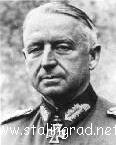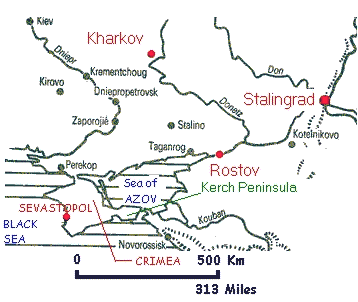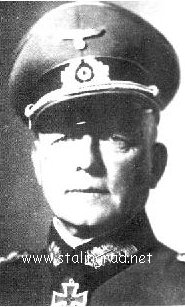|
Kerch
Peninsila - Operation Trappenjagd
8th May 1942
Three
Soviet armies with seventeen rifle divisions, two cavalry
divisions, three
rifle brigades and four tank brigades barricaded the narrow,
eighteen kilometer
Parpach Isthmus, the acces road from the Crimea to the Kerch
Peninsula.
Kerch on the other hand was a springboard across to the eastern
Black Sea coast
and thus to the approaches to the Caucasus. Each kilometer of
this vital bridge
was defended by about 10.000 Soviet soldiers, ten men to every
meter.
When one is facing an enemy three times as strong in a clever
defensive position,
one can only prevail with courage and cunning. And Manstein
based his plan on a
cunning strategy.
 Erich
von Manstein Erich
von Manstein |
|
By May 16 three
Soviet armies, 170.000 soldiers had been smashed in eight days
by a half-dozen German divisions. Before them lay the sea, the
Straits of Kerch,
and beyond, not twenty kilometers away, the shore of the Taman
Peninsula,
the approach to Asia, the entrance to the Caucasus. Manstein's
victory had
kicked open the backdoor to Stalin's oil paradise.

The Great
Battle South of Kharkov - Operation Fredericus
17th May 1942
Before the
Summer Campaign had taken place, 6th Army of Paulus and
1st Panzer Army of
Kleist
had been captured the Sovjet Balakleya-Izyum
salient near Kharkov. 1250 tanks and 2026 gunswere destroyed.
The Soviets losing 239.000 men as prisoner alone and the Germans
gaining
a valuable area from which to begin the new offensive. The
Soviets launched
an attack towards Kharkov on the 12th May 1942, pre-empting a
German
strike code-named 'Fredericus' in the same area by six days.
Although the
OKH commanded to start 'Fredericus', one day earlier, as planned
(17th instead of 18th May 1942).
A counter-attack, not defence, was believed to be the best
solution.
It was by the 22nd the enemy was encircled between von Kleist's
and
Paulus' armies and a great victory was achieved.

Ewald von Kleist
After Kerch and
Kharkov the German eastern army showed itself to be once
again at the peak of it superior strenght. Within three weeks
409.000 Soviet
soldiers taken prison, 3159 guns and 1508 tanks destroyed or
captured.
Victory dominated the minds of the soldiers and the Wehrmacht
communiques.
It certainly was amazing. But forgotten was the terrible winter
and the
spectre of defeat.
Sevastopol -
Operation Störfang
5rd June 1942
On June 5,
Richthofen's units were taken off against Sevastopol. The great
twenty-seven day battle against the strongest fortress in the
world had begun.
The VIII Fliegerkorps flew 1.000, 1.500 or 2.000 sorties daily.
The German term
for this non-stop air battle was "rollender Einsatz",
or attack in waves.
While the deadly rain of bombs fell from the sky above
Sevastopol, German
guns of every caliber hammered the enemy's system positions. The
gunners
sought out the enemy's emplaced batteries and fired round after
round at
the embrasures and armored cupolas of the concrete gun
positions.
It was a murderous overture. Never during the second world war,
neither before
nor after Sevastopol, was such a concentration of artillery
forces employed on
the German side. On July 3 it was over. Sevastopol, the
strongest fortress
in the world had fallen. On the desolate battlefield lay
thousands of dead as well
467 guns, 758 mortars and 155 anti-tank and anti-aicraft guns.
90.000 Red Army soldiers went into captivity.
After his victory
Erich von Manstein was promoted Fieldmarshall.
Manstein's 11th Army was now free for the big plan, for the
offensive
which was just geting under way against Stalingrad and the
Caucasus.
A
"Preparatory" Operation.
On June 22
General Eberhard von Mackensen, son of Fieldmarshall von
Mackensen,
had begun a "preparatory" operation. In combination
with elements of the First Panzer
Army he won jumping-off positions for the Sixth Army in the
Kupyansk area with a
small, successful battle of encirclement. The result was 24.000
prisoners and the
capture of territory across the Donets as far as the lower
Oksol.
The springboards for the launch into adventure of Operation Blue
had thus been won.
Now they couldn't swith the intermeshed gearing og the great
plan without
endangering everything. The fired-up machine had to run. X-Day
for Army Group
Weichs on the northern wing was June 28, for Sixth Army with
XXXX Panzer Corps
June 30.
The victorious
German divisions had no way of knowing that this success,
achieved through command skill and bravery, had opened the door
to a sad fate :
Stalingrad.
|